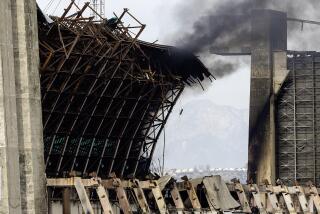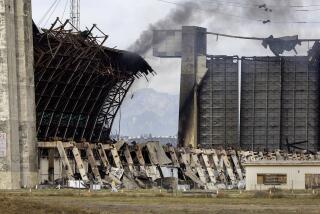Memo Shows Navy Was Told About Asbestos
- Share via
SAN DIEGO — Navy personnel who are supposed to oversee work done aboard ships said last week that they were unaware that a company’s workers aboard the aircraft carrier Ranger ripped out asbestos without using safety precautions--potentially exposing hundreds of sailors to the cancer-causing fiber.
But, according to a memo obtained by The Times, the Navy was informed Jan. 4 of problems aboard the vessel by the safety manager of another company that was working on the ship, who was concerned that sailors and his workers could be exposed to asbestos.
Workers for Continental Maritime of San Diego notified their safety manager, Tom Bohler, that two workers from California Marine Commercial Insulation were tearing out asbestos, without wearing respirators, protective clothing or sealing off the area. Bohler went aboard the Ranger to investigate. Beneath a sign reading “Asbestos Caution,” he found the two CMCI workers who told him they didn’t need protective gear.
At 10:50 a.m. Jan. 4, according to a memo written by Bohler, he spoke with Chief Petty Officer Donna Ward with the Supervisor of Ships Building, Conversion and Repair--the monitoring arm that is responsible for preparing contracts and overseeing work conducted on vessels.
“We wanted the government to be aware of it because they were also endangering the ship’s sailors,” Bohler said. “We wanted to let them know they had a real problem because people were in that area not knowing there was asbestos.”
Bohler “gave her (Ward) details of the incident, and she informed me that she would investigate the problem,” according to the memo addressed to Continental Maritime’s safety department and signed by Bohler.
Last Friday, CMCI and company president Frank Chavez pleaded guilty to failing to take adequate precautions when they removed more than 260 feet of pipes aboard the Ranger that were covered with asbestos. CMCI, which is also owned by Chavez, worked intermittently aboard the Ranger while the ship was docked at North Island Naval Station from Sept. 1989 to March 1990.
Capt. Vern Edwards, commanding officer of Supervisor of Ships Building, Conversion and Repair, told The Times earlier last week that he was unaware of any mishap concerning the asbestos removal.
“I have no idea about there being any problem anywhere,” Edwards had said. “I guess my responsibility as a supervisor is to ensure to the best of our ability that what we asked for in the contract is being executed in accordance with the contract.”
Edwards declined to return calls to his office Monday.
Reached by phone, Petty Officer Wards said: “We are not allowed to give any comments at all on this. The case is still under investigation. My only answer is ‘no comment.’ ”
Workers who believe they were exposed to the hazardous material expressed outrage Monday that the Navy’s own watchdog might have known about the careless asbestos removal procedures yet did not act to prevent them.
“They weren’t doing their job,” said Mike Calahan, a former pipe fitter. “Because they were not monitoring, I was basically thrown to the sharks. It’s like I am expendable as an employee. I have a death sentence.”
Asbestos, banned in 1979 for most construction purposes, can cause cancer and asbestosis, a fatal lung ailment. Asbestos is dangerous if it is inhaled into the lungs, where even one microscopic fiber can cause a fatal disease.
Part of the problem with asbestos cases, doctors and lawyers say, is that the disease can take from 10 to 40 years to develop. By the time disease develops, it’s often difficult for a doctor to trace the patient’s exposure to asbestos.
“Unfortunately, with the latency period, they won’t know for a long period of time,” said Tom Penfield, a San Diego attorney who specializes in asbestos cases. “It’s like somebody is playing Russian roulette with them.”
Aboard the Ranger, asbestos dust was in bathrooms, berthing areas, stairways and a kitchen, workers say. The ship’s ventilation system also was not properly sealed while the work was performed, said Assistant U.S. Atty. Melanie K. Pierson. This could have transported fibers throughout the ship, experts say.
“It is an outrage in this day and age to have those kinds of exposures--it is unconscionable,” said Dr. Arthur Frank, professor and chairman of the department of preventive medicine at the University of Kentucky.
But the hazards posed by the sloppy removal reach beyond the sailors and workers aboard the vessel, Frank said.
“Sailors who leave the ship would carry that material on their clothing, on their person and bring it home to their family.”
The Ranger, nicknamed “The Top Gun of the Pacific Fleet,” carries about 5,000 sailors and airmen at sea. While docked, the 1,000-foot-long ship would have a crew of about 2,800.
“It’s unknown who exactly was exposed--it happened eight months ago,” said Lt. Cmdr. Bob Pritchard, a Navy spokesman. Downplaying the possibility of sailors’ exposure, he added: “There’s a tremendous volume of free air that moves through that space.”
The federal charges, filed last week, against CMCI and Chavez, sprang from an eight-month investigation by the Naval Investigative Service. Chavez and CMCI were hired by Pacific Ship Repair & Fabrication, owned by David Bain, to remove and replace 1,100 feet of asbestos-covered pipes aboard the Ranger. The Navy paid Pacific Ship $211,000 for the renovation. Pritchard said, it is not known what part of that money was paid to CMCI, owned by Chavez, who is Bain’s father-in-law.
Although NIS has closed its investigation of CMCI and Chavez, the Pacific Fleet’s Air Force will begin investigating what occurred aboard the Ranger, Pritchard said.
“The health and welfare of our people is paramount,” he said. “If it’s determined that there has been an exposure, then we have a mechanism in place to deal with that.”
It is not yet known what steps--if any--the Navy has taken to inform sailors aboard the Ranger about the asbestos, Pritchard said.
More to Read
Sign up for Essential California
The most important California stories and recommendations in your inbox every morning.
You may occasionally receive promotional content from the Los Angeles Times.













